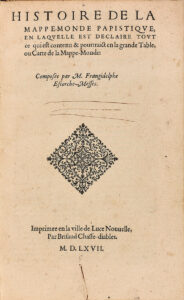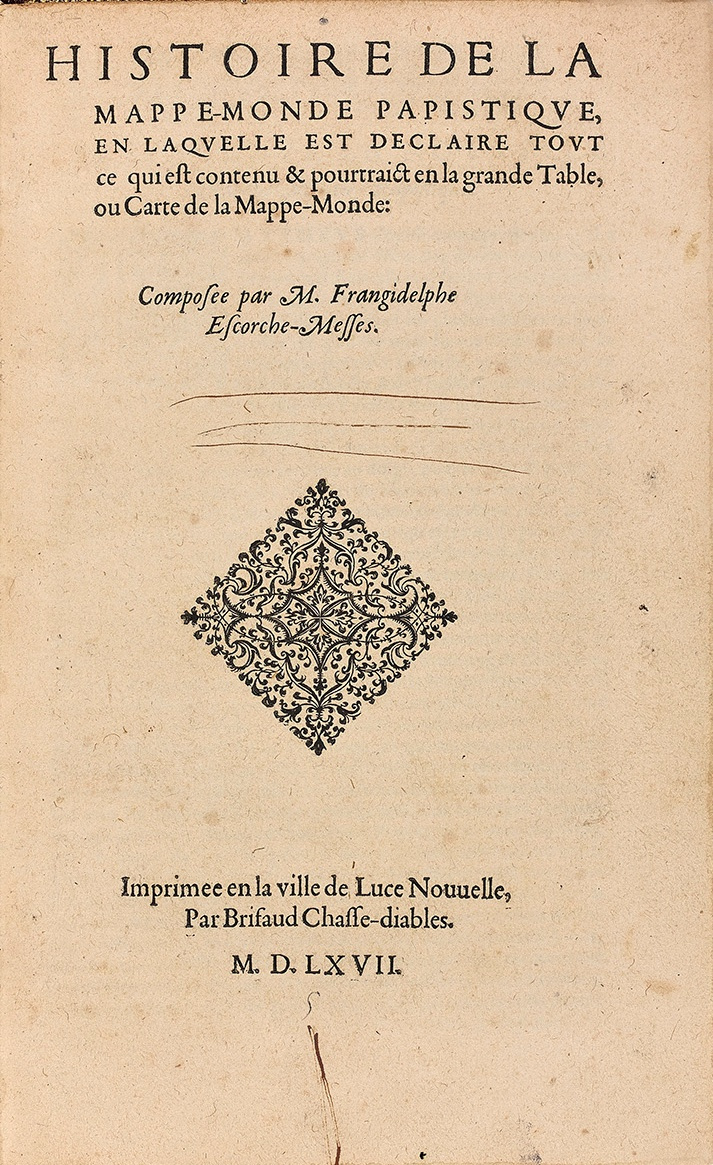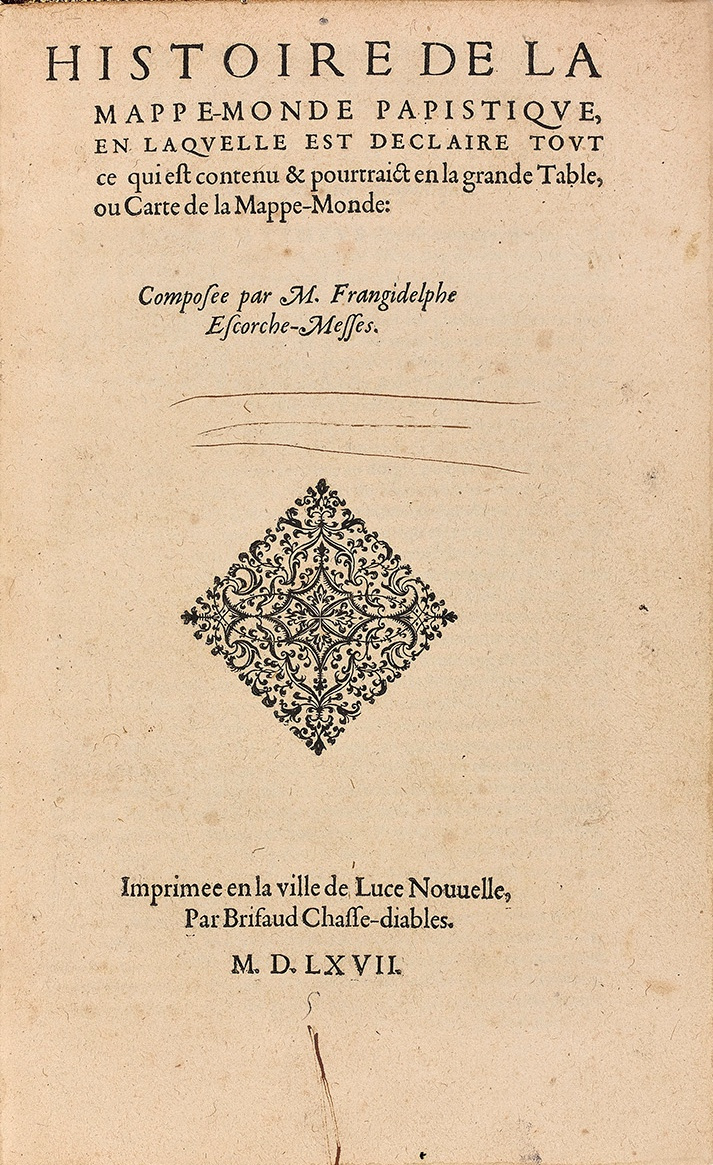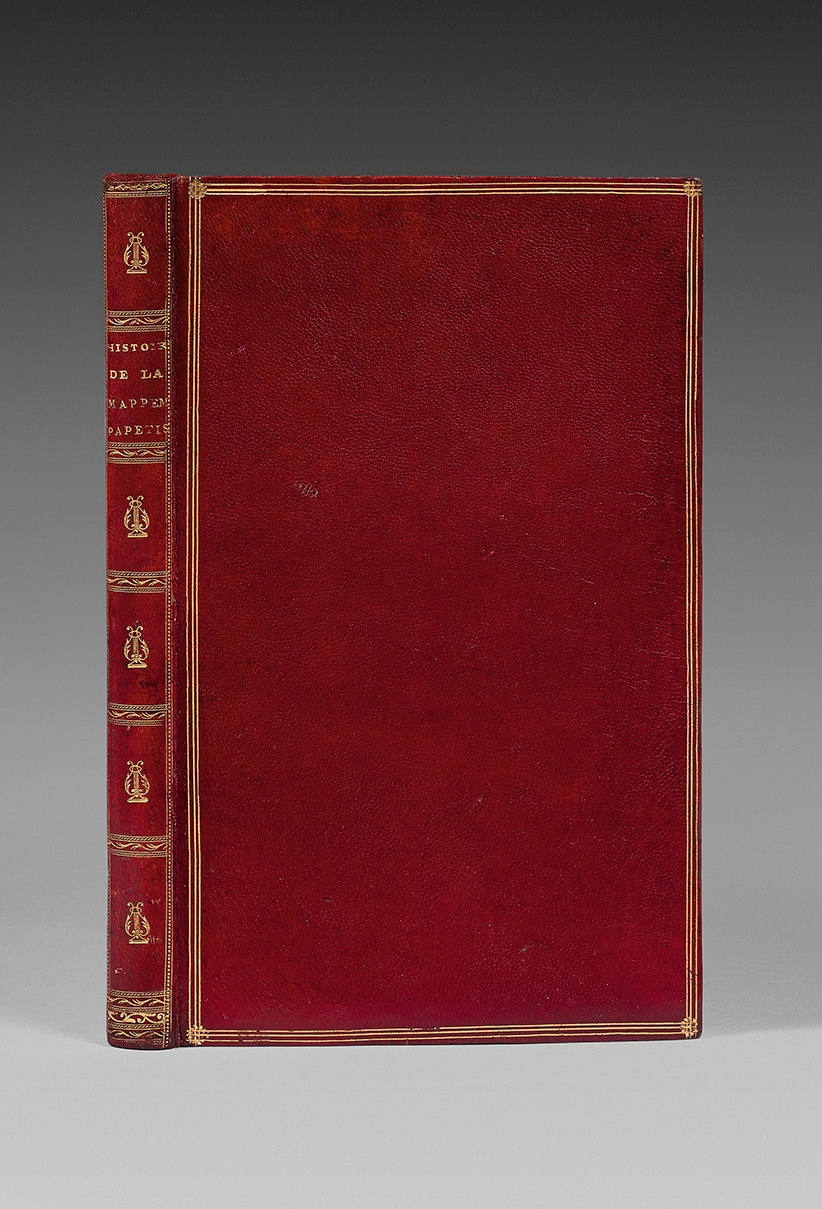Imprimée en la ville de Luce Nouvelle, par Brisaud Chasse-diables [Genève, François Perrin], 1567.
Large 8vo of (4) ll, 190 pp, (1) bl. l., few spotting, pale waterstain in the lower part of the last 7 ll.
Red morocco, triple gilt fillet around the covers, flat spine decorated with gilt fillets and lyres, decorated edges, gilt inner border, gilt edges. Bound by Derome le jeune with his label.
229 x 143 mm.
Very rare first edition of this violent satire against the court of Rome.
The work has long been attributed to Theodore de Bèze; in reality, under the Rabelaisian pun of the pseudonym Frangidelphe Escorche-messes is hidden the identity of Jean-Baptiste Trento, an Italian from Vicenza who converted to the Reformation in 1541 and took refuge in Geneva. He was received as a citizen of the city in 1559.
Copy from the second issue whose title bears the date of 1567 and not the one of 1566.
“Violent satire against the court of Rome. Copies are rare and sought after. The common opinion is that it is by Théod. de Bèze; however de Marolles says, in his Manuel, to have seen a copy on the frontispiece of which was the name of P. Viret, written by a contemporary hand” (Brunet, II, 1380, who knows only the issue of 1567).
“This bloody satire by Th. de Bèze against the court of Rome is also attributed to P. Viret” (Graesse, Trésor de livres rares, 629).
“Conceived on the initiative of Jean-Baptiste Trento, an Italian reformed refugee in Geneva, the ‘Mappe-Monde nouvelle papistique’ describes the imaginary territories of the papacy. In this allegorical map, which represents both the world and the city of Rome inside the devil’s mouth, we see the reformers storming the walls, Bible and sword in hand. The theophagous priests, who populate the province of Mass, are assimilated to savages of the New World, ‘naked of charity’ and greedy for human flesh… One can see there an allusion to the first catholic missions, and in particular Jesuits, in this country.
In the ‘History of the Papistic World Map’ or commentary of the map, Polydore Vergile is one of the most frequently alleged sources. It is a question of showing, through the book ‘Of the Inventors’, the very recent origin of the Papist Church, a Church which has decidedly nothing in common with that of Jesus Christ and the apostles. On chapters as different as fasting, images, ornaments, hospitals, incense, bulls sealed with lead, bell ringing, psalms sung in false drone, the purple habit of the cardinals or the vestimentary peculiarities of the various monastic orders, the ‘inventiveness’ is almost infinite, the faculty of innovation without limits. In this way, Trento carries out a true ethnographic investigation, casting a distant glance at the truly frightening spectacle of the dominant Church. Trento’s Brazil, both monstrous and fascinating, is the Rome of the popes, an otherness more frightening in truth than that of cartoon Indians.
During the Wars of Religion, Catholics and Protestants accused each other of savagery and bestiality. There is no doubt for the Catholic that the Protestant is a heretic, a Jew or a barbarian, whose blasphemies and iconoclastic violence revolts him. Conversely, the Protestant recognizes in the Catholic a Cannibal and, what is more, an idolater and a God-eater. Such is the hypothesis that develops abundantly ‘the Papistic World Map’ “. (Works miscellanea & theories of knowledge in the Renaissance, p. 55).
This is one of the most virulent Calvinist pamphlets of the xviith century; Trento calls for a second sack of Rome. Rarely the satire will have used such virulence: the author invites the reader to visit the various provinces of the Christianity, singularly the nineteen papal provinces; thus the provinces of the monkery, of the mass, of the clerics, of the pilgrimages, of the Sorbonne, etc. The whole is directed by the pope who corrupted the world with his “stinking drugs of superstitions & execrable idolatries”.
The visit of the various ecclesiastical buildings is the occasion to denounce the “stench & carrion of Jesuits, monks & presbyters“; it is recommended to be wary of the forests of this imaginary kingdom, because they are infested with “wolves, crocodiles, lions, tyrants, basilisks, & harpies, dressed as priests, monks, Jesuits, Quietins & Paulins, & Sorbonists, who kill in great quantities“.
“In the ‘Histoire de la Mappe-Monde Papistique’ that Jean-Baptiste Trento published in 1566 in Geneva under the pseudonym of Frangidelphe Escorche-Messes, the imaginary cosmography is used to describe a New World even more barbaric than the one that had just been discovered by the Spaniards and the Portuguese. Populating the deep forests of the provinces of Clerics, Mass and Sacramentary, the priests are represented as naked butchers, cannibals and theophagi. Since the Catholic religion ‘consists entirely of the Mass, and not of anything else’, the holy sacrament of the altar haunts this allegorical geography with its polymorphous and monstrous presence.”
The work is presented as the explanatory book of a world map, a map engraved by Pierre Eskrich, known in two copies in the world, both incomplete. The book, published after the map, forms a whole. It was sold separately.
Precious copy preserved in its elegant red morocco binding by Derome le Jeune with his engraved label dated 1785.
The copy comes from prestigious libraries: D.M. Méon (Paris, 1803, n°363) for whom the copy was bound; Antoine-Auguste Renouard (Paris 1854, n°157); Robert Samuel Turner with ex libris (Paris 1878, n°97); acquired at the sale of the latter by the bookseller Auguste Fontaine (catalog with marked prices, Paris 1879, n°129). The copy was then found at the sales of Pastor Goulden of Sedan (Paris 1921, n°192) and Edouard Moura (Paris 1923, n°57).




